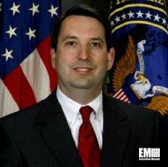 At ODNI, I was asked to become the program executive for security clearance reform in 2009, and then I became the deputy assistant director for special security and had pretty frequent interactions with Director Clapper, the director of National Intelligence.
At ODNI, I was asked to become the program executive for security clearance reform in 2009, and then I became the deputy assistant director for special security and had pretty frequent interactions with Director Clapper, the director of National Intelligence.
Those posts gave me real learning experience for the impact of security across the government. My takeaways were that when you’re working to transform a government‑wide process that has thousands of moving parts, billions of dollars involved and millions of people as stakeholders or prime actors in getting the job done, partnership is essential.
No one can drive change across the entire federal government. Of all things going on in the intelligence community, security reform was Director Clapper’s number two priority, after ICITE, the Intelligence Community Information Technology Environment.
Even as Director Clapper had the authority as Security Executive Agent to make change, he always worked with his partners at the Office of Personal Management, the Office of Management and Budget, and the Department of Defense, which is the largest clearance holder, when it came to making changes.
Director Clapper also had me form a government‑wide organization called the Security Executive Agent Advisory Committee, which has representatives from every department and agency, so that we could share what we were thinking of doing, get input from organizations as to what their priorities were, and to get feedback on the planned policies and procedures and oversight activities that we were going to perform before those things were implemented.
There are just so many different stakeholders in the clearance process, whether it’s industry, government, the military services, the intelligence community, the non‑title 50 organizations, that you need to communicate with and get feedback from. Those two things, communication and partnership, are essential. It doesn’t appear that everybody’s on the same page right now.
Where does continuous monitoring go from here?
 There are different opinions about the best way forward in security clearance reform, in general, and continuous evaluation, specifically. Frankly, at this stage of the game, that’s a good thing. We’re talking about potentially the largest change in the history of the personnel security process. I would be very uncomfortable if there just seemed to be one approach or one answer to the problem and everybody was going ahead full speed with that.
There are different opinions about the best way forward in security clearance reform, in general, and continuous evaluation, specifically. Frankly, at this stage of the game, that’s a good thing. We’re talking about potentially the largest change in the history of the personnel security process. I would be very uncomfortable if there just seemed to be one approach or one answer to the problem and everybody was going ahead full speed with that.
Over the next five years, you’ll gradually see a consensus built around either the right approach or some limited number of late approaches that should be tried out before we commit to making significant change in the clearance process. Some people might be disturbed by a statement that there’s not consensus. I happen to think that’s a very good thing at this point. Different opinions are being put forward, and over time, the best ideas will surface and be implemented.
Pursuing opportunities to help our government partners move forward is a big reason why I left government to come to industry. I’m just excited as can be about joining Salient Federal Solutions. Firms like Salient are committed to real change and helping the government improve their processes and enhance national security as we do it.
The good news is we have, I think, all the right players in place to make real change right now. I noted Director Clapper and Stan Sims at Defense Security Service, for example. I would say Mert Miller, who’s the Associate Director for Federal Investigative Services at the Office of Personnel Management, is another key player in the clearance process.
Mert is a real committed change agent, and I could not imagine a better leader at the Office of Personnel Management for playing a key role in clearance reform. Mert and I started the same week on the clearance reform project, so, I know first‑hand over the course of four and a half years what kind of committed leader he is.
John Fitzpatrick is at the Information Security Oversight Office, and plays a key role as chairman of the NISPPAC, the National Industrial Security Program Policy Advisory Committee, which is an open forum where all the players I’m talking about get together and discuss timeliness in the security clearance process and other issues. John is a tremendous leader and knows just knows so much about the subject and is one of the right people at the right place.
Lastly, I would say at Congress, both on the Senate Homeland Security and Government Affairs Committee, as well as the House Permanent Select Committee on Intelligence and the Senate Select Committee on Intelligence, the congressional staffers, the Congressmen and the Senators that are involved on this subject, it’s clear that folks are committed to real change.
All of those things put together are key ingredients to moving something as big as continuous evaluation forward. It’s not often when you see people across the board in the right places at the right time that can effect that real change. So I’m excited by the fact that I think the right people are in place across government on the legislative and executive branches to get the job done.




